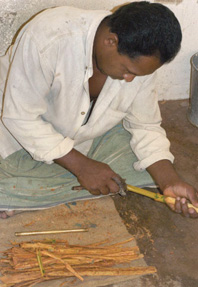

Cinnamon quills inserted into one another.
CINNAMON IN THE KITCHEN, BUT in the Bible? It is not the first plant or spice that comes to mind when thinking of the scriptures. Yet this well-known product of a tropical tree is a component of the holy anointing oil required for every priest: “Then the lord said to Moses, ‘Take the following fine spices: 500 shekels of liquid myrrh, half as much (that is, 250 shekels) of fragrant cinnamon, 250 shekels of fragrant cane, 500 shekels of cassia—all according to the sanctuary shekel—and a hin [archaic unit of measure equal to 1.5 gallons or 5.7 liters] of olive oil’” (Exodus 30:23–24, NIV). In addition to cinnamon, the related spice cassia (not to be confused with the legume with the same name) is included. Together, these two products of the genus Cinnamomum of the laurel family are cited seven times in the Bible.
The dried bark of Cinnamomum verum is the modern source of the spice cinnamon. While this tree can grow to be medium sized, it is grown in commercial plantations as a shrub. The stems are cut, the bark is burnished with a steel rod to loosen it, and strips of bark are cut off and dried. The curled, dried pieces are inserted into one another to create a “quill,” which is the form in which cinnamon is sold. Cinnamomum is native to Sri Lanka, and that island nation is the world’s largest producer. Oil can be distilled from the bark. An inferior but valued oil is obtained by distillation of the leaves.
Cinnamon, Cinnamomum verum, in the Royal Botanic Garden, Peridenya, Sri Lanka. In culture, cinnamon is pruned to maintain it as a shrub.

Removing cinnamon from the stems of Cinnamomum verum, at the Cinnamon Research Station, Sri Lanka.
In ancient times, cinnamon was almost certainly derived from Cinnamomum aromaticum, native to China but widely grown in east Asia and translated in some verses as “cassia.” The Hebrew and Greek words for both cinnamon and cassia are borrowed words. It is therefore not clear in the scriptures which species was used, but based on records from ancient trade it was likely C. cassia (Miller 1969). Today, C. aromaticum is considered inferior, and most of the commercially produced cinnamon is C. verum.
Miller (1969) cautions us not to think of ancient uses of spices as entirely similar to modern uses. We think of spices as condiments, something to be added to food. For the ancients, these plant products were also ingredients in ointments, medicines, perfumes, embalming potions, love philtres, charms, and anodynes. And this is how cinnamon, as well as other spices, are used in the Bible.
Cinnamon as a love philtre is mentioned in conjunction with the alluring woman who says: “I have perfumed my bed with myrrh, aloes and cinnamon” (Proverbs 7:17, NIV) (O’Connell 1991). In Solomon’s timeless love song, cinnamon is mentioned along with other plants, notably nard, saffron, and calamus (Song of Solomon 4:14).
In the Bible, cinnamon was used for its oil, although it is unclear whether that oil was from the bark or the leaves. Cinnamon was a highly valued commodity in the ancient world and is listed along with other luxury items in Ezekiel: “Danites and Greeks from Uzal bought your merchandise; they exchanged wrought iron, cassia and calamus for your wares” (Ezekiel 27:19, NIV). And the final mention of cinnamon in the Bible is on a similar list of luxury items in the last book: “Cargoes of cinnamon and spice, of incense, myrrh and frankincense, of wine and olive oil, of fine flour and wheat; cattle and sheep; horses and carriages; and bodies and souls of men” (Revelation 18:13, NIV).
Limited to a few occurrences, cinnamon is nevertheless found from the second book of the Bible to the last. It was highly valued and widely traded in ancient times.